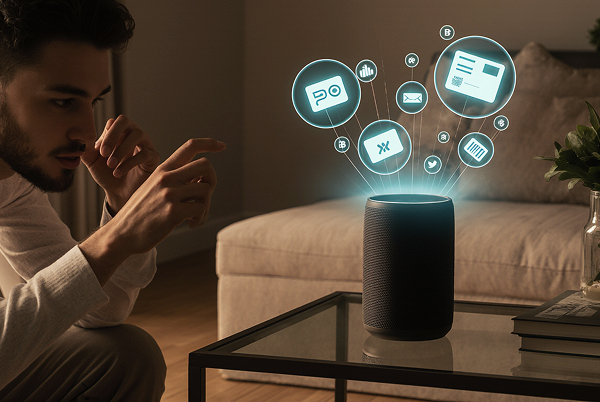Voice Commerce and AI: The Next Frontier in Digital Shooping
A New Way to Buy, Without Lifting a Finger
For years, ecommerce has focused on visuals—scrolling, swiping, and tapping our way through catalogs. But the next disruption won’t be seen. It will be heard.
Voice commerce, powered by artificial intelligence, is transforming how consumers discover, compare, and purchase products. From Amazon’s Alexa to Google Assistant, and even in-app AI agents, the spoken interface is evolving into a seamless, intuitive layer between human intent and digital action.
In an era where consumers crave convenience and personalization, voice commerce is emerging as the natural evolution of shopping—literally.
When AI Becomes the Salesperson
What makes voice commerce powerful isn’t just the ability to say “Order toothpaste” and have it arrive the next day. It’s the intelligence behind the voice.
Modern AI systems combine natural language processing (NLP), predictive analytics, and contextual learning to interpret tone, intent, and even emotion. That means a voice assistant can move from being a passive order-taker to an active shopping partner.
Imagine this:
“Hey Kardynal, I’m running low on coffee.”
“Would you like to reorder your usual Ethiopian roast from Blue Bottle or try a new blend on discount today?”
This is the future of conversational commerce—AI systems that don’t just hear words, but understand needs.
And the impact is real. According to Juniper Research, global spending via voice assistants is projected to reach $164 billion by 2025, up from just $22 billion in 2020. That’s not a fad; it’s a shift in behavior.

Search Without Searching
Voice commerce changes more than how we buy—it changes how we search.
Traditional ecommerce relies on typed keywords and filters. Voice, on the other hand, demands contextual intelligence. When a user says, “Find me a lightweight jacket for spring,” the assistant has to infer climate, location, past purchases, and style preferences in one go.
That’s where AI recommendation engines come in. By merging real-time voice intent with stored user data, AI can deliver hyper-personalized suggestions that feel conversational rather than transactional.
Retailers like Walmart, Target, and Best Buy are already integrating voice-based reorder systems that connect to user accounts and purchase histories. Meanwhile, Domino’s lets customers order pizza via voice in 20+ markets, reducing friction while increasing order frequency.
The takeaway: voice isn’t replacing visual shopping—it’s augmenting it, creating a faster path from intent to purchase.
Voice Meets Fintech: The Payment Revolution
The biggest friction point in any shopping journey is checkout. Voice commerce, combined with fintech innovation, is tackling that head-on.
Through biometric authentication (voice ID) and tokenized payments, users can complete secure purchases without touching a screen. Banks and payment providers are exploring voice-verified transactions—think “Pay my credit card bill” or “Transfer $200 to savings”—with the same level of security as a fingerprint scan.
In the retail space, this means your voice could soon be your wallet. Amazon Pay already allows Alexa users to complete transactions with a simple confirmation phrase. Other fintech players are experimenting with “embedded voice wallets” that integrate with ecommerce platforms directly.
Voice payments remove the need for manual entry, making transactions faster, safer, and more natural—especially on mobile devices or in smart home environments.
The Challenges: Privacy, Trust, and Discovery
Of course, the shift to voice-led commerce isn’t frictionless.
- Privacy remains a concern—users need to know how their voice data is stored and used.
- Trust in recommendations will be key; if assistants prioritize sponsored listings over genuine fits, users will disengage.
- Discovery is different in a voice-first world—unlike a webpage, you can’t “see” multiple results at once. AI must be precise, fair, and transparent.
To succeed, brands will need to balance personalization with privacy, ensuring users feel in control of their data and decisions.
The Opportunity for Retailers
Voice commerce is still in its early stages—about where mobile shopping was in 2010. The brands that win won’t just add “voice skills” to their apps; they’ll build end-to-end voice journeys integrated with CRM, payments, and post-purchase support.
For example, an AI assistant like Kardynal could:
- Recommend products based on spoken preferences.
- Read expert reviews aloud.
- Compare prices or deals across merchants.
- Complete checkout through voice confirmation.
- Send order tracking updates automatically.
That’s not just a feature—it’s an entirely new customer experience layer.

The Future Speaks
Voice commerce represents more than convenience; it’s the next evolution of human-centered digital commerce. As AI gets better at understanding intent, tone, and context, the line between conversation and conversion will blur.
In the next decade, we won’t just talk to our devices—they’ll talk back, intelligently, helping us shop, save, and spend smarter.
For retailers, the question isn’t if voice commerce will matter, but how soon they’ll be ready to listen.




%201.svg)
%201.svg)



.svg)
.svg)
.svg)